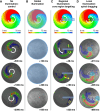Monitoring and modulating cardiac bioelectricity: from Einthoven to end-user
- PMID: 39716965
- PMCID: PMC11711590
- DOI: 10.1093/europace/euae300
Monitoring and modulating cardiac bioelectricity: from Einthoven to end-user
Abstract
In 2024, we celebrate the 100th anniversary of Willem Einthoven receiving the Nobel Prize for his discovery of the mechanism of the electrocardiogram (ECG). Building on Einthoven's legacy, electrocardiography allows the monitoring of cardiac bioelectricity through solutions to the so-called forward and inverse problems. These solutions link local cardiac electrical signals with the morphology of the ECG, offering a reversible connection between the heart's electrical activity and its representation on the body surface. Inspired by Einthoven's work, researchers have explored the transition from monitoring to modulation of bioelectrical activity in the heart for the development of new anti-arrhythmic strategies, e.g. via optogenetics. In this review, we demonstrate the lasting influence that Einthoven has on our understanding of cardiac electrophysiology in general, and the diagnosis and treatment of cardiac arrhythmias in particular.
Keywords: Einthoven; Electrocardiography; Forward problem; Inverse problem; Mechanism of arrhythmia; Nobel Prize; Optogenetics; Reentry.
© The Author(s) 2024. Published by Oxford University Press on behalf of the European Society of Cardiology.
Figures







Comment in
-
Commemorating the 1924 Nobel Prize awarded to Willem Einthoven: a century of progress in electrocardiography and arrhythmia research.Europace. 2024 Dec 26;27(1):euae309. doi: 10.1093/europace/euae309. Europace. 2024. PMID: 39729542 Free PMC article. No abstract available.
References
-
- van Hemel NM, van Dessel PFHM, de Bakker JMT. The Glass Recordings of Willem Einthoven. A Selection of Electrocardiographic and Other Registrations Made in the Years 1894–1931. Houten, the Netherlands: Bohn Stafleu van Loghem-Houten Nederland; 2019. p27.
-
- Snellen HA. Willem Einthoven (1860–1927) Father of Electrocardiography: Life and Work, Ancestors and Contemporaries. Dordrecht/Boston/London: Kluwer Academic Publishers; 2002. p98.
-
- de Waart A. Het Levenswerk van Willem Einthoven 1860–1927. Haarlem: Erven F. Bohn; 1957.
-
- Einthoven W, Jaffe A, Venge P, Lindahl B. Galvanometrische registratie van het menschelijk electrocardiogram. Leiden, the Netherlands: Herinneringsbundel Professor SS Rosenstein; 1902. p101–7.
Publication types
MeSH terms
Grants and funding
LinkOut - more resources
Full Text Sources
Medical

